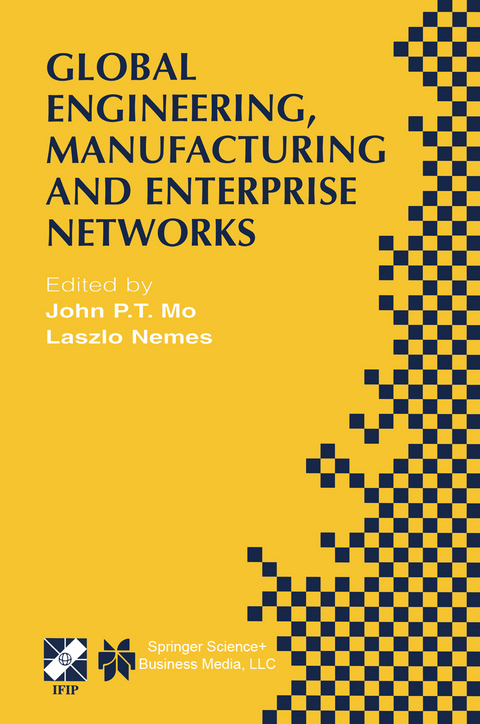
Global Engineering, Manufacturing and Enterprise Networks
Springer (Verlag)
978-0-7923-7358-2 (ISBN)
The availability of effective global communication facilities in the last decade has changed the business goals of many manufacturing enterprises. They need to remain competitive by developing products and processes which are specific to individual requirements, completely packaged and manufactured globally. Networks of enterprises are formed to operate across time and space with world-wide distributed functions such as manufacturing, sales, customer support, engineering, quality assurance, supply chain management and so on. Research and technology development need to address architectures, methodologies, models and tools supporting intra- and inter-enterprise operation and management. Throughout the life cycle of products and enterprises there is the requirement to transform information sourced from globally distributed offices and partners into knowledge for decision and action. Building on the success of previous DrrSM conferences (Tokyo 1993, Eindhoven 1996, Fort Worth 1998), the fourth International Conference on Design of Information Infrastructure Systems for Manufacturing (DrrSM 2000) aims to: • Establish and manage the dynamics of virtual enterprises, define the information system requirements and develop solutions; • Develop and deploy information management in multi-cultural systems with universal applicability of the proposed architecture and solutions; • Develop enterprise integration architectures, methodologies and information infrastructure support for reconfigurable enterprises; • Explore information transformation into knowledge for decision and action by machine and skilful people; These objectives reflect changes of the business processes due to advancements of information and communication technologies (ICT) in the last couple of years.
One Keynote.- Accessing Corporate Memory — Some Knowledge Structure Concepts.- Two Virtual Enterprises.- Virtual Enterprise Architecture and its Supporting Methods/Tools for Managing Supply Chain System Life Cycle.- Flexible Infrastructure for Virtual Enterprises.- Assessing Ability to Execute in Virtual Enterprises.- Project-specific Process Configuration in Virtual Enterprises.- Functional Requirements for Inter-enterprise Intranet Services.- The Architecture of an Internet-based Virtual Industrial Community.- From Single Enterprises to Complementary Networks.- Three Modelling and Analysis of Virtual Enterprises.- Use of GERAM as Basis for a Virtual Enterprise Framework Model.- The Component-oriented Approach towards Complex Product Development.- Supporting Partner Selection for Virtual Enterprises.- Specifying Interactions in Integrated Manufacturing Systems.- Modelling Semiosis of Design.- Modelling for Designing, Managing and Improving Virtual Enterprises in One-of-a-kind Business.- An Adaptive Process Management System (APMS).- Modelling Requirements for Self-integrating Manufacturing Systems.- Four Supply Chain Management.- Ergonomic Concerns in Enterprise Resource Planning (ERP) Systems and Its Implementations.- Low-cost System for Supply Chain Management.- A Booking Type Production System as a Collaboration Method for Virtual Enterprises.- Collaborative Design Procedure for Supply Chain Process Integration Using UML.- Agent-based Architecture for Flexible Lean Cell Design, Analysis and Evaluation.- Supply Chain Business System Reference Model: A Business Process Description Using IDEF0.- Five e-Commerce and e-Service.- B2B E-Commerce Infrastructure Using Agents and Standards — A Potential Impact Analysis and Architecture.- A Web-based Bidding Workbench forGlobal Manufacturing.- Web-based maintenance manual with three-dimensional simulation model.- e-Service for Complex Technical Products — a New Approach for Supporting Life-cycle Services.- Automated Management of Quality Control System for Network Enterprise.- Neo-kaizen Applications on the Generic Operations Support and Renewal.- Six Product Development and Life Cycle Management.- Towards Information and Knowledge in Product Realization Infrastructures.- Requirements on Product Information Management in the Sales and Service Life-cycle Phases of a Plant.- A VR-based CAD System.- Dependencies Between Design Product Models and Simulation Models.- A Manufacturing Information Infrastructure to Link Team Based Design to Global Manufacture.- Non-destructive Tracing of a Product Life Cycle Through Geometry Extraction from Radiographs.- Planning for Manufacturing — Managing Connective Designs and Asymmetric Designer Knowledge in Product Consortia.- Product Modelling and Rationale Capture in Design Process.- Agent Design for LCC Information Gathering.- Information Technology and Telecommunication Infrastructure: Network Applications for Hong Kong Business and Service.- Seven Knowledge Management.- Background and Foreground Knowledge in knowledge management.- Standardised Model Data Exchange for Dispersed Systems Engineering Design Teams.- Knowledge Creation at FORTUM Engineering.- Formal Ontology for Participative Simulation.- Managing Technical Documentation for Large Defence Projects: Engineering Corporate Knowledge.- AGORA: An Integrated Knowledge Management Environment.- Eight Information Technologies for Manufacturing.- A Multi-agent Based Information Infrastructure for Manufacturing.- A Cost Estimation Tool Integrated into FIPER.- Collaboration and ApplicationIntegration: Distributed Design with Virtual CAD.- World Wide Web Adapted Geometric Model in the Context of Functional Design.- Moving XML to a Manufacturing Enterprise.- Manufacturing Enterprise Integration Using Simulation Software to Coordinate Budget Planning.- Nine Computer Integrated Manufacturing.- An Expert System for Plasma Cutting Process Quality Prediction and Optimal Parameter Suggestion.- A Computation and Control Architecture of Virtual Manufacturing Shop.- Managing the Flow of Information on the Factory Floor.- Holonic Architecture for Shop-floor Control.- Software Technology for Design System Integration.- Agility Through Design — The Holonic Multi-cell Control System (HoMuCS) Architecture.- Implementation of a Layer Structured Control System on the ‘Glue Logic’.
| Reihe/Serie | IFIP International Federation for Information Processing ; 63 |
|---|---|
| Zusatzinfo | XVI, 496 p. |
| Verlagsort | Dordrecht |
| Sprache | englisch |
| Maße | 155 x 235 mm |
| Themenwelt | Mathematik / Informatik ► Informatik ► Theorie / Studium |
| Mathematik / Informatik ► Informatik ► Web / Internet | |
| Wirtschaft ► Allgemeines / Lexika | |
| Wirtschaft ► Betriebswirtschaft / Management ► Marketing / Vertrieb | |
| ISBN-10 | 0-7923-7358-8 / 0792373588 |
| ISBN-13 | 978-0-7923-7358-2 / 9780792373582 |
| Zustand | Neuware |
| Haben Sie eine Frage zum Produkt? |
aus dem Bereich


